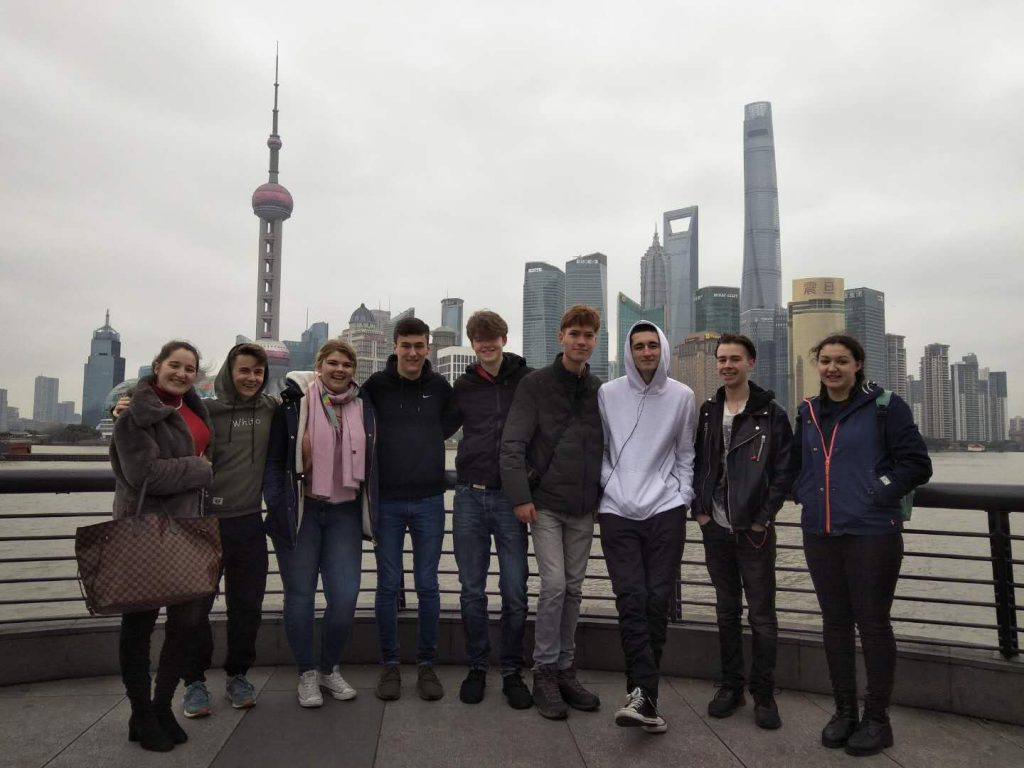时髦的上海
在外滩上视着浦东的高楼林立令你感觉你好像不在中国了。在一方面,这是一个十分现代化的城市。摩天大楼四处都有,其规模大得让人惊叹不已,眼花缭乱。这便是中国最近飞速发展的产物。不过,还有一部分追溯到殖民地时期的古老建筑作为历史的证明。这一群欧洲风格的建筑高度低,表面上用石头替玻璃,显得有些格格不入。远离外滩,在上海其他地区,外国与本地文化之间的对比一样显明。这个城市由许多高速穿过,多数本地人住在20多层的公寓,但在法国人居住区,上海很多的超级富豪当中,最常见的住所和一个公寓泾渭分明。在这里,法式的小房子好像仍旧是最盛行的一种住宅。该房子全部都有自己小的花园,在中国的城市里面这是从未见过的。再者,街道上似乎也能看到法国文化的影响:中国当地的面馆和餐馆这边很少,但你却反复会碰到咖啡店。可爱的小点有的是,不过,这毕竟是上海,这座繁荣之城有巨大的一切,而咖啡店也不意外。在南京西路的环岛上,有世界最大的星巴克咖啡。这个圆形建筑的样子别具一格,里面的墙上都是棕色的压花铜板。游客可以看着人工(其中的外国人也不少)用奇特的机器来做咖啡。要牢记一点:上海这个地方的老百姓早上一般可不和咖啡,上海人却最爱喝一碗两八宝粥或豆浆。一碗的价格最高是5块钱,谁要一杯这个洋气时尚的咖啡则很可能要付30多块钱。在我心目中,这个例子概括上海:这早就是一个兴旺与极其开放的城市,今天也是如此。怪不得这个文章的内容都是法式的房子与西方的名牌。

At the Bund in Shanghai with other volunteer teachers from our group (fourth from the right is me)
ENGLISH:
Gazing out at the skyscrapers of the Bund you feel you are no longer in China. On the one hand, this is indeed a very modern city. There are skyscrapers everywhere whose scale will leave you speechless. These, of course, are there thanks to China’s very fast growth in recent years. However, some buildings still date back to colonial times and are evidence of Shanghai’s history. These European-style buildings – low, and with stone covering their surface instead of glass – still seem a little out of place. Further away from the Bund, in other areas of Shanghai, the contrast between local and foreign culture is equally striking. The city is intersected everywhere by motorways, and most locals live in apartment blocks at least twenty storeys high, but in the French quarter, amongst China’s many super-rich, it is a different story. Here it is still small French-style houses which are the most popular. These houses all have their own small garden, which is something that I had never before seen in a Chinese city. The influence of French culture is also visible on the streets: here there are few of the usual restaurants serving noodles and stir-fries, but instead many cafes. Many of these are small, but this is after all Shanghai, the booming city which has huge everything, and cafes are no exception. On a roundabout on West Nanjing Road is the largest Starbucks in the world. The round building looks like something else: inside all the walls are covered with patterned copper boards. Visitors can watch the staff, many of whom are foreigners, use wacky machines to make the coffee. Remember – ordinary Shanghainese don’t tend to drink coffee in the morning, but instead drink a bowl of eight-treasures porridge or soy milk. A bowl of that stuff will cost you at most 5 yuan, but if you want a trendy foreign coffee you will probably pay as much as thirty. In my eyes, these examples sum up Shanghai: this place became early on a hugely prosperous and very open city and has remained so ever since. No wonder this piece of writing is all about French houses and western brands.
